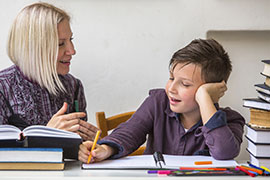When students need extra behavior support
Try these techniques for resolving problem behavior
4 key universal approaches
- Building rapport
- Establishing/teaching performance expectations
- Behavior-specific positive reinforcement
- Using the 4:1 ratio of praise-to-corrective redirection
Learn more in The Teacher’s Pocket Guide for Effective Classroom Intervention, Second Edition.
Here are some recommended Tier 2 supports:
Check and Connect
Alexa
Alexa, an 8th grader, was performing well enough in most classes, but when it came to math and science, she encountered significant difficulties. Not only were these courses academically challenging for Alexa, she lacked coping mechanisms to manage her frustration. Subsequently, Alexa frequently cut class. When she did attend, she was often disruptive.
Alexa’s Check and Connect program consisted of weekly meetings. During these meetings, Alexa was given the opportunity to discuss her concerns about math and science as well as some peer issues that disturbed her. She also received encouragement and coaching in how to interact appropriately with her teachers. At the same time, Alexa’s teachers received coaching in how to review performance expectations and how to provide encouragement to Alexa. As her academic performance and behavior improved, Check and Connect meetings tapered off.
Check-In/Check-Out
Samuel
Check-in/Check-out was a strategy initiated with Samuel, a 3rd grader who required frequent redirection from his teacher, was aggressive to his classmates, and threw temper tantrums when frustrated. On a daily basis, Samuel checked in with the school’s assistant principal to prepare for the rest of the day. During these morning meetings, Samuel received a daily progress report card that he carried with him throughout the day. He used the card to assess his own performance, had it signed by his mother every evening, and submitted it at check-in the next morning.
Samuel’s teachers provided him with feedback after each class and also completed electronic daily progress reports that were sent to the assistant principal in time for Samuel’s afternoon check-out meeting. On days when Samuel’s positive self-assessment matched the assessments of his teachers, he received points and praise. On days when his behavior failed to meet expectations, he received encouragement and was helped to come up with coping strategies for the future. In less than two months, Samuel’s behavior was within normal limits and the meetings were gradually discontinued.
Check, Connect, and Expect
Selina
Selina is a 6th-grade student who appeared to be painfully shy but had no history of acting in a manner that was considered disrespectful toward others. Although she made reasonable academic progress, her teachers expressed concern about her persistent withdrawn appearance and change in affect when working with other students. Staff concern had particularly grown in association with Selina’s complaints of stomach pain and nausea, resulting in frequent trips to the school nurse.
While her parents pursued health assessments, Selina began meeting with one of her teachers at the start of each school day, about 10 minutes before homeroom period. The teacher provided some brief words of encouragement and went over targeted goals on Selina’s weekly goal card. Selina’s goals emphasized the use of calming skills to better cope with feelings of stress she might be experiencing. Each teacher provided Selina with private encouragement throughout each class period for appropriate interaction with peers and completed an assessment of Selina’s performance, which were reviewed in a brief end-of-the-day meeting.
The targeted supports, which included discussion of triggers of Selina’s episodes and preventive strategies emphasizing sleep, nutrition, and exercise, helped Selina function throughout each school day.
Social Skills Instruction
Tyler
Participation in a weekly school-based social skills group helped Tyler, a high school student identified as having an emotional disturbance, handle behavioral difficulties arising during physical education classes. Tyler had trouble following class rules and was frequently involved in altercations with peers during competitive games.
In the 8-week-long group, facilitated by a school guidance counselor and several teachers, Tyler learned to resolve conflicts through role-play and social skills instruction. After completing the training, Tyler’s behavioral problems diminished significantly.
Mentoring
Julie
Julie, a bright, high achieving 10th grader experiencing stress, anxiety, and sleep disturbance, received significant relief from a variety of interventions including the establishment of a mentoring relationship with a local college student. Mentor and student met 2–3 times a week at first and later on an “as needed” basis.
The guidance counselor, who provided training to the mentor, also worked closely with Julie and her parents to ensure that the mentoring relationship was on track and that Julie received a referral to a local community mental health agency.


